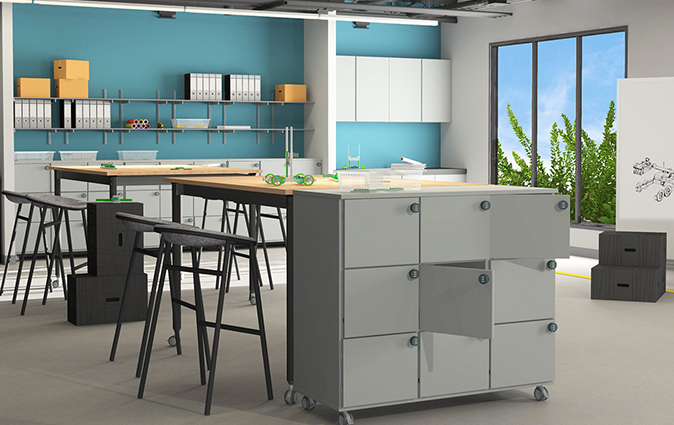
From the moment we enter the world, our minds never stop learning. Everything we see, hear and feel is processed daily to create memories, patterns and associations.
Of course, learning comes in many forms. In the traditional academic environment, we’re taught with structure. These curriculums and examinations assess us at different stages of our lives. But from a cognitive standpoint, in particular, among young children, we also learn simply by acknowledging what’s around us.
This is known as experiential learning. As children and adults, we interact with stimuli and learn through experience – rather than theory, as often seen in the classroom. The best academic environments blend this theoretical learning with real-life experiences.
The story behind experiential learning
The theory of experiential learning dates back to 1984, as coined by educational theorist David Kolb.[1] Experiential learning is based on a four-stage ‘cycle’ of learning. Within this, there are four separate learning styles. For example:
The cycle of experiential learning
Concrete experience → reflective observation → abstract conceptualisation → active experimentation.
This never-ending cycle starts with doing or having the experience, followed by reviewing the process. Once we’ve reflected on it, we conceptualise it by learning, and then we experiment by trying out what we’ve learned – and hence the process starts again.
Kolb’s learning styles
We can then apply our different learning styles to these stages. Many things influence the learning style, for example cognitive structures or social environments. These styles are broadly categorised by our behaviours in terms of processing (approaching a task) and perception (how we feel about it).
As such, we have four different learning styles:
• Diverging: based on feeling and watching
• Assimilating: based on thinking and watching
• Converging: based on thinking and doing
• Accommodating: based on feeling and doing.
With a better understanding of how individuals process experiential learning, we can create better learning environments.
Experiential learning in adults
Experiential learning puts no emphasis on teachers to guide the way. Instead, it lets us shape our own experiences and perceive our environments in whichever way works best for us.
This is why there can often be conflict in the workplace – for example, if everybody is involved in the same training course. What’s most important, as adults, is to listen to one another and take note of body language.
According to Janie Thompson[2] of MTA, we should not try to dominate or take leadership during an experiential learning process. This could be something as trivial as a sports game team-building exercise. We need to encourage each other to interact with stimuli and learn at our own pace.
Applying experiential learning to children
Perhaps surprisingly, experiential learning is not entirely different with children. Adults still need praise and encouragement, while they also need to learn to ignore distractions. Conflicts are just as common in adulthood if communication breaks down.
When it comes to experiential learning in kids, the main difference is the stimuli. Adults may be learning with a practical creative task, cooking, or a driving a car. Children, on the other hand, may be learning with toys, nature or simple household objects.
Learning through play
In the broadest sense, we can refer to this as learning through play. Experiential learning teaches children key problem-solving skills for later life. The best way to encourage experiential learning is by transforming everyday experiences into learning opportunities.
For example, if we want to work on our children’s mathematical skills, we can offer a play grocery store environment. That way, they can use the practical application of mathematics to calculate the total price of a grocery list. Nobody is forcing them to do it this way; they reach their own conclusion by identifying the problem and coming up with solutions to solve it.
Using all the senses
The brain is most ‘plastic’ – that is, susceptible to learning – between the ages of two and three. At these ages, neurons and synapses increase far more than in adulthood. Our synapses increase from 2,500 to 15,000 per neuron, giving us more capacity to absorb information.[3]
It’s this ‘plasticity’ that allows us to learn how to walk and talk. As we age, these synapses decrease in number. You’ve probably heard the term “their brains are like sponges”. For even more ‘absorbent’ learning, children should be encouraged to use all their senses.
This is because using different senses lights up different areas of our brains. Therefore, by mixing visual, tactile and audial learning, we can store information far more efficiently. According to the journal Trends in Cognitive Sciences, people remember:
• 10 per cent of what they read
• 20 per cent of what they hear
• 30 per cent of what they see
• 50 per cent of what they see and hear.[4]
As such, it’s up to us as educators to provide this multi-sensory experience. For example, we should let children play outside, touch nature, and point out stimuli such as large buildings.
Experiential learning for additional needs
Students with autism may struggle to learn in a traditional, structured environment. A common trait for those on the autism spectrum is to fixate on certain objects[5], for example, trains. Teachers can use experiential learning by using toy trains to teach – for example, “calculate how long it takes to reach X station”. By using context, the child can learn without being overwhelmed.
Likewise, students with autism may struggle with:
• Concentration
• Anxiety
• Self-confidence
• Connecting/interpreting social cues.
With experiential learning, the process is completely tailor-made[6] to one individual student. This allows the student to engage more deeply, while enjoying the benefits of one-on-one communication with the teacher.
Again, by using natural problem-solving skills, these children can improve their self-confidence. Experiential learning may also strengthen natural bonds with others, helping children with autism to improve their interpersonal skills.
How can teachers encourage experiential
learning in the classroom?
To encourage practical problem-solving, creativity and social skills, teachers should apply these practices in the classroom:
Use context in every learning scenario.
As above, teachers should encourage everyday skills as a way of solving everyday problems. For example, children may try addition and subtraction in the ‘grocery store’.
Praise the good – don’t punish the bad.
Experiential learning is crucial for children to understand the difference between success and failure[7]. Teachers should encourage self-confidence by praising children when they perform well. Conversely, they should not scold students when they make a mistake. Instead, teachers should provide constructive feedback and encourage them to try again.
Promote a range of outcomes.
Oftentimes there are many more ways to solve a problem than the obvious. Teachers should encourage students to try all outcomes, noting how they react. This will help students to develop their social skills by learning assertiveness and conflict resolution.
Learn from the children.
Occasionally teachers should see the world through the student’s lens. There may be an alternative perspective that we have not considered, as we’re used to doing things a certain way. Children are observing and learning all the time, so if they offer an alternative approach, consider this for future improvements.
Create an environment for experiential learning.
The best experiential learning environments will encourage students to make use of space, nature, and all their senses. Learning does not need to be constrained to the classroom, nor one particular space. Students can learn at different heights, indoors or outdoors, or with natural stimuli like trees and grass. They can also benefit from specific props to enhance their learning.

How classroom furniture fosters an
experiential learning environment
At Muzo, we have spent years creating classroom furniture that meets the needs of each student. As such, we’re proud of our experiential learning range that encourages creativity, productivity, and the use of all senses.
Engaging at different levels
Students learn best when they are relaxed, and often younger students are asked to sit on the floor. The MBob floor seat provides robust back support at a ground level. This allows kids to learn outdoors, touch the grass, read a book or just relax during social interactions. Likewise, these can be levelled up when paired with low learning tables, encouraging collaboration.
Trying a range of applications
Products such as the Xbrick help students to learn with context. This multi-functional tool can be used to build up and down, promoting physical education, creative skills or simple social interactions. The Xbrick is great for sitting on, drawing on, or supporting larger structures. Children can use this to visualise everyday situations and solve problems.
Experimenting with colours
Visual stimuli are crucial for effective early learning, which is why all our chairs and tables come in a varied colour palette. In particular, certain colours encourage certain emotions. Yellow, for example, is ideal for performing arts environments as it promotes energy and happiness.[8]
Flexible collaboration and individual learning
Experiential learning can take place alone or in groups. With our Kite tables, students can gather together to learn through play, and break away when needed. Likewise, individual dividers can free older students from distractions, allowing them to focus on the task in hand.
Lower reverberations for minimal stress
Children with additional learning needs may become overwhelmed by too many stimuli. Muzo’s dividers are made with soft materials to absorb sound, ensuring that children do not suffer from sensory overload. Again, this allows them to concentrate in a calming environment.
Grouping items together by context
Products such as the Stashbox allow students to organise their personal items for better learning. They can then apply context to this, for example, gathering plastic fruit and vegetables for re-enacting the grocery store. This helps to build organisational skills and word associations.
Why we all need experiential learning
Whether we’re visual, audial or sensory learners, thinkers or doers, we all benefit from learning in context. Experiential learning gives us that freedom to learn at our own pace, without the constraints of leaders or curriculums to follow.
By improving our external environment, we can take our experiential learning even further. With proven benefits for self-esteem, problem-solving and social skills, we should all be encouraging experiential learning at every stage of our lives.
Contact Muzo for the full experiential learning product brochure here.
—Notes
[1] https://www.simplypsychology.org/learning-kolb.html
[2] https://www.experientiallearning.org/about-mta/what-is-experiential-learning/
[3] https://sciencing.com/the-relationship-between-age-plasticity-12760666.html
[4] http://learnthroughexperience.org/blog/power-of-context-learning-through-senses/
[5] https://www.iidc.indiana.edu/irca/articles/teaching-tips-for-children-and-adults-with-autism.html
[6] https://vantagepointaspiro.com/blog/what-is-experiential-learning-and-how-it-can-help-your-child/
[7] https://www.melbournechildpsychology.com.au/blog/play-experiential-learning-early-childhood/
[8] https://elearningindustry.com/the-elearning-color-guide-evoking-the-right-emotion
















